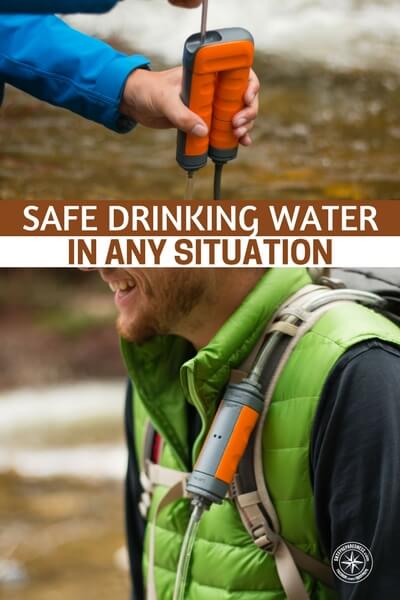SHTFPreparedness may collect a share of sales or other compensation from the links on this page.
Safe drinking water is important! Learning about the ways you can assure you and your family have safe water to drink could save your life.

Everyone agrees that you should have an emergency supply of water. Most experts advise that you should have a minimum water supply of 72 hours.
The CDC recommends that you have 1 gallon of water for each person in your family for each day. If you have a family of four, you will need 12 gallons of water for those 72 hours.
This is pretty easy to do with bottled water. Bottled water is pre-packaged and has clear expiration dates so you know that the water is still safe to drink.
Getting access to safe drinking water becomes a little more difficult if you need to abandon your home or if the emergency lasts longer than 72 hours. Each case requires an understanding of water safety, contamination, and treatment.
How To Get Safe Drinking Water
Choose The Right Water Source

Water from flowing streams and rivers is always preferable to stagnant water in ponds or lakes.
Always try to choose water as close to the water source as possible. In many cases, spring water coming out of the ground will be the safest for drinking.
As much as possible, try to avoid water that is downriver from towns and industries. Waste and pollutants often find their way into the water systems.
Likewise, water near agricultural land can be a problem. Fertilizers and pesticides soak into the land, and through rainfall and runoff, they will get into the streams and rivers.
Avoid water in marshes and swamps or where algae are growing. Finding the cleanest water will make your life much easier.
With that being said, there are times when you do not have any choice about the water that is available to you. This is where it is best that you understand the potential contaminants in the water and the technology needed to remove them.
Know Possible Water Pollutants
In order to make water completely safe to drink, you’ll need to eliminate the following five types of contaminants:
- Turbidity: visible dirt (sand, silt or mud)
- Chemical pollutants: from heavy metals to pesticides, are often associated with mining, agriculture, and forestry
- Viruses: a biological agent that reproduces in the cells that they infect
- Bacteria are single-cell organisms found everywhere. Some of them cause infectious diseases. (These include E. Coli, cholera, typhoid, etc.)
- Parasites: waterborne parasites are single-cell organisms (such as protozoa, Cryptosporidium, and Giardia) or multi-cell organisms (such as worms) that live in or on other living organisms.
How to Purify Water
Depending on the level of contamination that you are dealing with, there are a variety of methods from which you can choose.
Water purification technology has advanced quite a bit over the last few years and there are numerous methods for getting rid of the nastiness in contaminated water.
Unfortunately, getting clean, safe, and good-tasting drinking water requires more than one filtration medium. Below are different filtration methods and what they remove.
Boiling

Boiling water for at least one minute will kill or deactivate all viruses, pathogens, bacteria, and protozoa.
This is an easy way to filter water with no special equipment and you can treat a lot of water at one time so it is good for large groups or families.
Boiling does not remove chemical pollutants or clarify turbidity in the water. Boiling also requires a fuel source to burn, which is sometimes difficult to come by.
Filtration
A water filter is generally a device that blocks impurities or particles from passing through it. This works through size exclusion, where the holes in the filter are so small that the bacteria cannot fit.
This kind of filtration is usually called Hollow Fiber.
Adsorption
Adsorption normally refers to a product like activated carbon. There are a few forms of activated carbon (granular, powder, and fiber). The small pores in the carbon increase the surface area of adsorption.
Activated carbon is ideal for removing chemicals, metals, and turbidity of water. It also improves the taste of your water and has faster flow rates.
Activated Carbon Fiber is a fibrous adsorbent that has 10x higher adsorption than traditional activated carbon and gives you faster flow rates.
UV Light Purifiers
SterPen Ultra UV Water Purifier Adventurer Opti UV Personal Water Purifier
Adventurer Opti UV Personal Water Purifier CrazyCap Water Purifier Cap with UV-C LED
CrazyCap Water Purifier Cap with UV-C LED
This method uses UV rays to blast microbes and organisms in the water. This neutralizes them and renders them harmless to humans.
UV purifiers require a power source (generally batteries) and are potentially fragile, leaving you without filtration.
Water Filtration Products
LifeStraw

One of the most popular filtration straws on the market, originally designed as an emergency water treatment method, the LifeStraw is well suited for spending time in the backcountry. It’s also cheap and great to throw in an emergency pack.
The LifeStraw has a hollow fiber membrane filter that cleanses the water as you sip it straight from the source. LifeStraw does not remove viruses and can only be used directly from the water source.
Hand Pumps
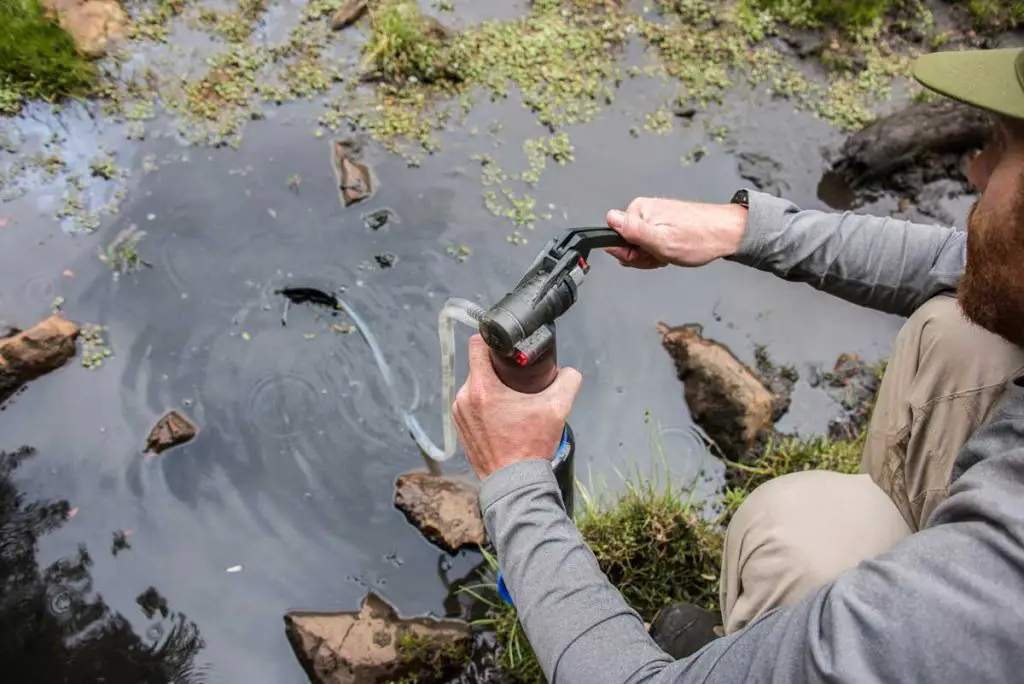
Hand pump filters are common for backpackers and have the ability to filter large amounts of water. They are generally reliable and easy to use.
Hand pumps have small filter pore sizes so they can remove more particulate, but this reduces the flow rate of water. Most hand pumps are heavy and have multiple pieces that can get lost. Also, very few hand pumps can remove viruses.
A few hand pumps were recently released on the market that can give you complete viruses protection.
Gravity Filters

Gravity filters are a three-step process: perfect for groups of people at a campsite! It is also great if you have time to set up a semi-permanent installation.
Most gravity filters have a large water reservoir that can be filled with dirty water, a tube that is connected to the filter medium, and another tube attached to the clean water receptacle.
Hollow-fiber gravity filters are made of, which allows for fast flow rates. Gravity filters are hassle-free, lightweight, and can collapse down to save space.
These systems do not protect against viruses and you need quite a bit of water to make the system work.
In-Line Filters
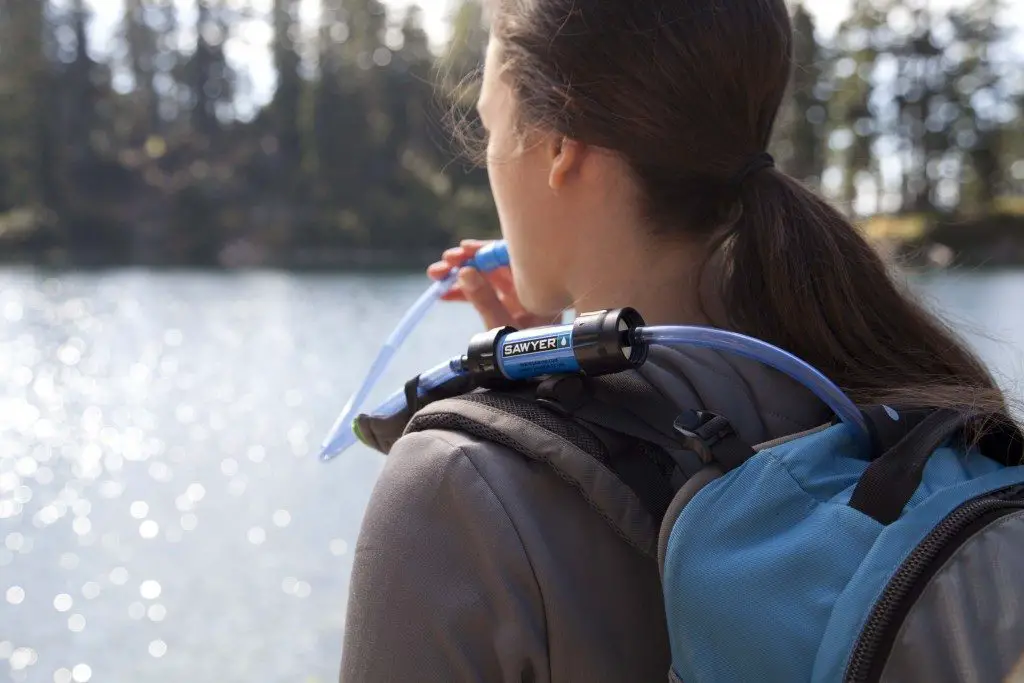
Another very common filter is an in-line filter and most people are aware of the Sawyer Mini. It is one of the lightest filters on the market.
Check out its many uses and benefits:
- economical
- use it with a water reservoir
- add to a collapsible canteen
- use it as a straw
- thread onto a water bottle
This type of filter will filter up to 100,000 gallons if you continue to backflush it and take care of the filter.
Great for a single user, but not very good for larger groups.
This type of filter also does not remove viruses and does nothing to remove chemicals and metals.
Chemical Treatment
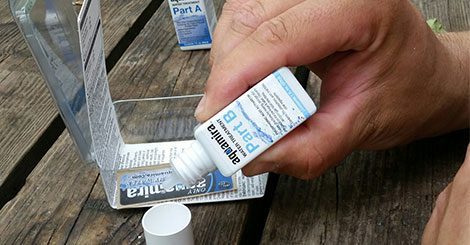
Chemical water treatment methods, most commonly contain iodine or chlorine dioxide. This is a lightweight option, good for treating large amounts of water. It also kills viruses found in the water.
The downside is that it takes a few hours to treat the water and leaves a negative taste in the water.
This treatment does not remove the turbidity of water.
MUV Adaptable Water Filter
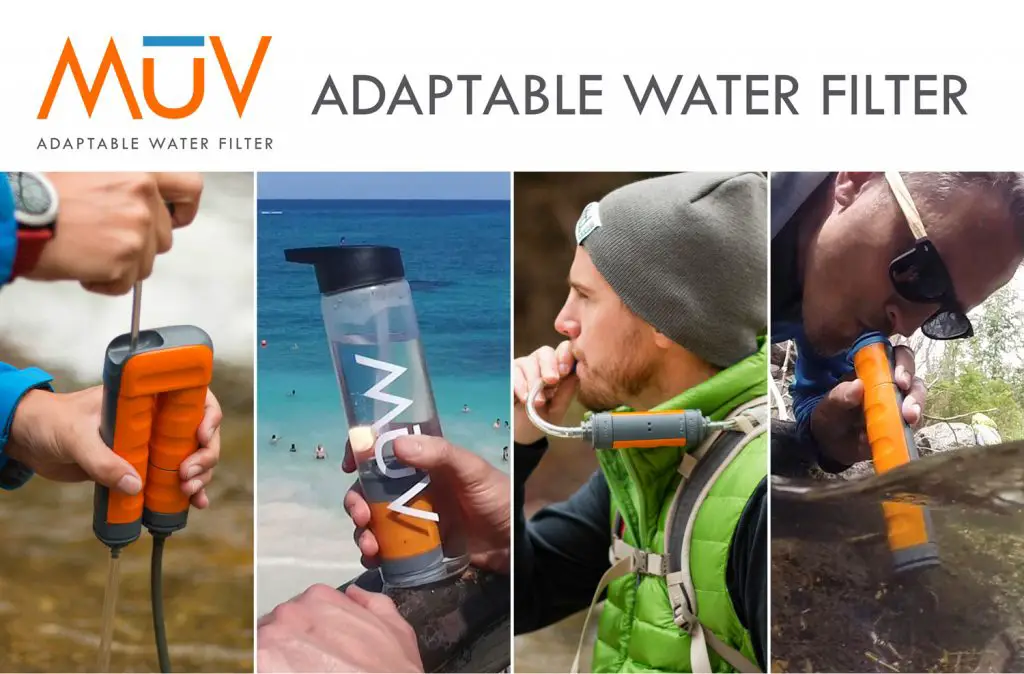
A small company out of Utah recently released an adaptable water filter that they believe fixes many of the problems with single-use water filters.
The MUV Adaptable Water Filter is a multi-stage water filter that can be modified and used based on the water contamination that you are dealing with.
Not only does it remove all of the water pollutants covered above, including viruses, but it is also very versatile.
You can easily modify the filter to work in a water bottle, as an in-line filter, as a gravity system, as a straw threaded onto a 28-mm soda bottle, and as a pump.
Released on Kickstarter a couple of years ago, the MUV was fully funded in just 72 hours. Take a look at the video below to learn more about it.
This is now available at Amazon, making it easy to order for your next trip or to have in an emergency.




